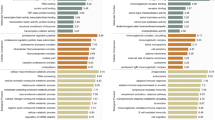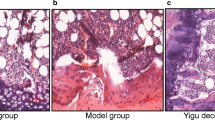Abstract
Proteomical analysis is defined as the characterization of the entire set of protein encoded a genome. Two-dimensional electrophoresis (2-DE) and matrix-assisted laser desorption/ionization–time of flight mass spectrometry (MALDI-TOF MS) are main techniques used in proteomic analysis to achieve information about protein expression profiles. Knowledge about the mechanism of skeletal fluorosis can be gained by recognizing changes in protein expression. To better understand the skeletal fluorosis process, osteoblasts isolated from calvarial of neonatal mouse were cultured and treated with 2 ppm fluoride for 72 h, and proteins of the osteoblast were profiled by 2-DE. With the analysis of Image-Master 2D analysis software, we detected a total number of 493 matching spots on 2-DE images. Among them, 28 protein spots showed twofold significant alteration (P < 0.05) in fluoride-exposed groups. Moreover, 12 proteins were identified by MALDI-TOF MS. These identified proteins in fluoride-exposed group were associated with cell proliferation, metabolism, and oxidative folding. Thus, our study provides useful information on fluoride-related changes of proteome and shows that proteomical analysis is a powerful methodology for the better understanding of skeletal fluorosis.


Similar content being viewed by others
Reference
Kassem M, Mosekilde L, Eriksen EF (1994) Effects of fluoride on human bone cells in vitro: differences in responsiveness between stromal osteoblast precursors and mature osteoblasts. Eur J Endocrinol 130:381–386
Zhang WL, Cui YN, Gao S (2003) Expression of proto-oncogenes c-fos and c-jun in osteoblasts activated by excessive fluoride. Zhonghua Yu Fang Yi Xue Za Zhi 37:246–250
Wilkins MR, Pasquali C, Appel RD (1996) From proteins to proteomes: large scale protein identification by two-dimensional electrophoresis and amino acid analysis. Biotechnology 14:61–65
Rabilloud T (2002) Two-dimensional gel electrophoresis in proteomics: old, old fashioned, but it still climbup the mountains. Proteomics 2:3–10
Heath JK, Atkinson SJ, Meikle MC (1984) Mouse osteoblasts synthesize collagenase in response to bone resorbing agents. Biochim Biophys Acta 802:151–154
Xu H, Hu LS, Chang M (2005) Proteomic analysis of kidney in fluoride-exposed rat. Toxicol Lett 160(1):69–75
Li HY, Zhang WL, Hua K (2004) The effect of fluoride on osteoblast. In: Li GS (ed) Pathogenesis of endemic fluorosis. Science Publishing House, Beijing, China, pp 76–106
Zhang Y, Sun GF, Jin YP (2003) Effects of fluoride on proliferation and differentiation of rat osteoblasts in vitro and the antagonistic action of vitamin C. Zhonghua Lao Dong Wei Sheng Zhi Ye Bing Za Zhi 21:250–252
Miao Q, Liu BC, Zhang XC (2003) Cloning of differentially displayed cDNAs involved in NaF-treated osteoblasts. Zhonghua Yu Fang Yi Xue Za Zhi 37:251–255
Low LK, Shin HC, Narayan M (2000) Acceleration of oxidative folding of bovine pancreatic ribonuclease A by anion-induced stabilization and formation of structured native-like intermediates. FEBS Lett 472:67–72
Baker A, Dos Santos B, Powis G (2000) Redox control of caspase-3 activity by thioredoxin and other reduced proteins. Biochem Biophys Res Commun 268:78–81
Tu BP, Weissman JS (2004) Oxidative protein folding in eukaryotes: mechanisms and consequences. J Cell Biol 164:341–346
Chlubeka D (2003) Fluoride and oxidative stress. Fluoride 36:217–228
Guo XY, Sun GF, Sun YC (2003) Oxidative stress from fluoride-induced hepatotoxicity in rats. Fluoride 36:25–29
Arimura N, Inagaki N, Chihara K (2000) Phosphorylation of collapsin response mediator protein-2 by Rho-kinase: evidence for two separate signaling pathways for growth cone collapse. J Biol Chem 275:23973–23980
Fukata Y, Itoh TJ, Kimura T (2002) CRMP-2 binds to tubulin heterodimers to promote microtubule assembly. Nat Cell Biol 4:583–591
Acknowledgments
This work was supported by grant for fluorosis proteomical research from National Natural Science Foundation of China (30271156).
Author information
Authors and Affiliations
Corresponding author
Rights and permissions
About this article
Cite this article
Xu, H., Jing, L. & Li, GS. Proteomic Analysis of Osteoblasts Exposed to Fluoride In Vitro. Biol Trace Elem Res 123, 91–97 (2008). https://doi.org/10.1007/s12011-007-8086-3
Received:
Accepted:
Published:
Issue Date:
DOI: https://doi.org/10.1007/s12011-007-8086-3




